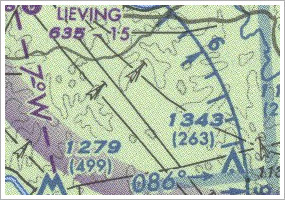| The following stories from the November 7, 2008, edition of AOPA ePilot were provided to AOPA members who expressed an interest in the particular subject areas. Any AOPA member can receive information tailored to their areas of interest by updating their preferences online. TRAINING TIPsPower lines
Over wooded or cultivated regions where power line rights of way stretch for miles, their narrow, sometimes snow-filled corridors extending to the horizon make reassuringly easy landmarks for visual flying. Their checkpoint value increases if the flight must be flown at lower altitudes that would render more compact, distant landmarks useless. On sectional aeronautical charts, power transmission lines are depicted with a solid black line punctuated by symbolic supporting towers, illustrated on page 21 of the VFR Chart Symbols section of the Aeronautical Chart User's Guide . Note the different symbol used on world area charts.
Power lines are noted under runway information as a hazard on approach to Runway 36 at the Waterbury-Oxford Airport in Connecticut (OXC) in AOPA's Airport Directory Online .
It's the frequent proximity of power lines to airports that makes them hazards to takeoffs and landings—another reason to always demand maximum performance from your aircraft during initial climb. Using less than all available takeoff runway, or hesitancy to apply full throttle for takeoff, can put hazards in play. See the cautionary tales contained in the October 2008 AOPA Flight Training's " Accident Analysis."
And, when practicing simulated engine failures during training, scan the emergency landing field you select for power line hazards. That might spare you the rude surprise encountered by a Cessna 182 pilot during a true off-airport landing recounted in " Never Again: Gone Fishing" in the July 2004 AOPA Pilot. You may not have a choice about dealing with power lines during an actual emergency. Spotting them early could make the crucial difference. TRAINING PRODUCTSAERO 600 Avionics CleanerFingertip smudges on an LCD avionics display can be a distraction and a nuisance. Aero 600 Avionics Cleaner and a soft cloth can be used to banish smudges, dirt, and dust. The company's "secret formula" contains no alcohol or ammonia and is non-toxic. The product can be used on GPS displays, laptop screens, and sunglasses. The four-ounce bottle sells for $14.99 and can be ordered online or by calling 413/229-9042. Note: Products listed have not been evaluated by ePilot editors unless otherwise noted. AOPA assumes no responsibility for products or services listed or for claims or actions by manufacturers or vendors. FINAL EXAMQuestion: If I am on a cross-country flight and running a little behind, is it OK to use my cell phone in flight to notify my friends?
Answer: FAR 91.21 prohibits pilots operating under IFR from using any portable electronic device while in flight. And the FCC has a regulation that prohibits the use of a cell phone on any aircraft in flight. Specifically, FCC Rule 22.925 states, "Cellular telephones installed in or carried aboard airplanes, balloons, or any other type of aircraft must not be operated while such aircraft are airborne." So, using a cell phone—whether VFR or IFR—is prohibited in flight.
Got a question for our technical services staff? E-mail to [email protected] or call the Pilot Information Center, 800/872-2672. Don't forget the online archive of "Final Exam" questions and answers, searchable by keyword or topic. |
 When studying charts and other published airport information before flying a cross-country, you are noting many details. Prominent landmarks for visual navigation and obstacles on the approach to the destination's runways top the list. Electrical power transmission and telecommunications lines fall into both categories. Often easy to spot from cruise altitude, power lines make excellent checkpoints that frequently can be followed for many miles. When not so easy to spot, as during takeoff or landing, or when situated along roads as potential obstructions to emergency landing sites, they can be hazardous indeed.
When studying charts and other published airport information before flying a cross-country, you are noting many details. Prominent landmarks for visual navigation and obstacles on the approach to the destination's runways top the list. Electrical power transmission and telecommunications lines fall into both categories. Often easy to spot from cruise altitude, power lines make excellent checkpoints that frequently can be followed for many miles. When not so easy to spot, as during takeoff or landing, or when situated along roads as potential obstructions to emergency landing sites, they can be hazardous indeed.

